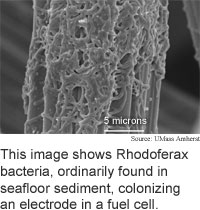
Bacteria make more electricity
One solution to humans seemingly insatiable appetite for energy is to let bacteria do most of the work.
Researchers from the University of Massachusetts at Amherst have identified a microorganism that is particularly good at converting sugars to electricity under natural conditions.
The researchers used the organism in a simple, clean microbial fuel cell. Fuel cells generate a flow of electricity by pushing electrons out one electrode and receiving them back through a second electrode.
The UMass Amherst researchers showed that the marine sediment bacterium Rhodoferax ferrireducens can directly transfer to an electrode the electrons generated as it feeds. This makes for a fuel cell that is 80 percent efficient at converting the energy locked up in sugar's chemical bonds to electricity, compared to 50 percent for previous microbial fuel cells.
The bacteria feed on glucose, which is the main form of sugar in the environment; fructose, which is common in fruits; sucrose, which is contained in sugar cane and sugar beet; and xylose, which is found in wood and straw.
The bacterial fuel cell generates about 100 times less power than
today's hydrogen fuel cells. This gap can be narrowed by improving the
electrode and by genetically modifying the bacterium, according to the
researchers.
It will take a year or possibly considerably longer to develop
a practical microbial fuel cell, according to the researchers. The work
appeared in the September 7, 2003 issue of Nature Biotechnology.
E-paper closes in on video
Magnetic memory makes logic
Old idea retooled for security
Crystal slows and speeds light
News briefs:
Process orders nanowire arrays
CD writer generates holograms
Nanotubes boost storage
Nanotubes harvest electrons
Bacteria make more electricity
Design enables large neural nets

Research Watch blog
View from the High Ground Q&A
How It Works
RSS Feeds:
News
Ad links:
Buy an ad link
Ad links: Clear History
Buy an ad link
|
TRN
Newswire and Headline Feeds for Web sites
|
© Copyright Technology Research News, LLC 2000-2010. All rights reserved.